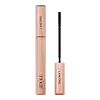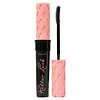Lancôme Lash Idôle Flutter Extension Lengthening Mascara Versus Benefit Cosmetics Roller Lash Mascara
What's inside
What's inside
 Key Ingredients
Key Ingredients

No key ingredients
 Benefits
Benefits

 Concerns
Concerns

 Ingredients Side-by-side
Ingredients Side-by-side

Water
Skin ConditioningCI 77499
Cosmetic ColorantAcrylates Copolymer
Oryza Sativa Cera
Skin ConditioningPropylene Glycol
HumectantCera Alba
EmollientPentylene Glycol
Skin ConditioningGlyceryl Stearate
EmollientCetyl Alcohol
EmollientPEG-200 Glyceryl Stearate
Copernicia Cerifera Cera
EmollientStearic Acid
CleansingPalmitic Acid
EmollientGlycerin
HumectantMyristic Acid
CleansingAminomethyl Propanediol
BufferingHydroxyethylcellulose
Emulsion StabilisingCaprylyl Glycol
EmollientXanthan Gum
EmulsifyingSodium Dehydroacetate
PreservativeWater, CI 77499, Acrylates Copolymer, Oryza Sativa Cera, Propylene Glycol, Cera Alba, Pentylene Glycol, Glyceryl Stearate, Cetyl Alcohol, PEG-200 Glyceryl Stearate, Copernicia Cerifera Cera, Stearic Acid, Palmitic Acid, Glycerin, Myristic Acid, Aminomethyl Propanediol, Hydroxyethylcellulose, Caprylyl Glycol, Xanthan Gum, Sodium Dehydroacetate
Water
Skin ConditioningParaffin
PerfumingPolybutene
Cera Alba
EmollientBis-Diglyceryl Polyacyladipate-2
EmollientPalmitic Acid
EmollientStearic Acid
CleansingVp/Eicosene Copolymer
Acacia Senegal Gum
MaskingCopernicia Cerifera Wax
Aminomethyl Propanediol
Buffering1,2-Hexanediol
Skin ConditioningCaprylyl Glycol
EmollientSilica
AbrasiveEuphorbia Cerifera Wax
Hydroxyethylcellulose
Emulsion StabilisingPanthenol
Skin ConditioningButylene Glycol
HumectantHydroxyacetophenone
AntioxidantChlorphenesin
AntimicrobialPentylene Glycol
Skin ConditioningTocopheryl Acetate
AntioxidantAlgin
MaskingSerine
MaskingDisodium Phosphate
BufferingSodium Phosphate
BufferingPolysorbate 60
EmulsifyingIron Oxides
Water, Paraffin, Polybutene, Cera Alba, Bis-Diglyceryl Polyacyladipate-2, Palmitic Acid, Stearic Acid, Vp/Eicosene Copolymer, Acacia Senegal Gum, Copernicia Cerifera Wax, Aminomethyl Propanediol, 1,2-Hexanediol, Caprylyl Glycol, Silica, Euphorbia Cerifera Wax, Hydroxyethylcellulose, Panthenol, Butylene Glycol, Hydroxyacetophenone, Chlorphenesin, Pentylene Glycol, Tocopheryl Acetate, Algin, Serine, Disodium Phosphate, Sodium Phosphate, Polysorbate 60, Iron Oxides
 Reviews
Reviews

Ingredients Explained
These ingredients are found in both products.
Ingredients higher up in an ingredient list are typically present in a larger amount.
We don't have a description for Aminomethyl Propanediol yet.
Caprylyl Glycol is a humectant and emollient, meaning it attracts and preserves moisture.
It is a common ingredient in many products, especially those designed to hydrate skin. The primary benefits are retaining moisture, skin softening, and promoting a healthy skin barrier.
Though Caprylyl Glycol is an alcohol derived from fatty acids, it is not the kind that can dry out skin.
This ingredient is also used as a preservative to extend the life of products. It has slight antimicrobial properties.
Learn more about Caprylyl GlycolCera alba is beeswax, or the wax used by bees to make honeycombs. It is a texture-enhancer and emollient. A study from 2003 found beeswax to be a stronger emollient than ingredients such as petroleum jelly.
As an emollient, beeswax helps hydrate the skin by creating a barrier on top. This barrier traps moisture in.
Emulsifiers help prevent ingredients from separating. This helps create consistent texture.
The structure of beeswax is mainly long-chain alcohols and the esters of fatty acids.
There are three types of beeswax: yellow, white, and absolute. Yellow is pure beeswax taken from the honeycomb. White beeswax is created by filtering or bleaching yellow beeswax. Absolute beeswax is created by treating beeswax with alcohol. Beeswax used in cosmetics are purified.
Beeswax has been used throughout history and even in prehistoric times. Some common uses for beeswax still used today are making candles, as a waterproofing agent, and polish for leather.
Learn more about Cera AlbaHydroxyethylcellulose is used to improve the texture of products. It is created from a chemical reaction involving ethylene oxide and alkali-cellulose. Cellulose is a sugar found in plant cell walls and help give plants structure.
This ingredient helps stabilize products by preventing ingredients from separating. It can also help thicken the texture of a product.
This ingredient can also be found in pill medicines to help our bodies digest other ingredients.
Learn more about HydroxyethylcellulosePalmitic Acid is a fatty acid naturally found in our skin and in many plant and animal sources. In cosmetics, it is usually derived from palm oil. It serves many purposes in skincare, acting as a cleanser, emollient, and emulsifier.
As an emollient, palmitic acid helps soften and smooth the skin by preventing water loss. In cleansers, it helps remove oil and dirt while creating foam.
Its emulsifying properties help stabilize products by keeping water and oil-based ingredients from separating.
This may not be suitable for fungal acne-prone skin, as fatty acids like this can sometimes trigger breakouts in sensitive individuals.
Learn more about Palmitic AcidPentylene glycol is typically used within a product to thicken it. It also adds a smooth, soft, and moisturizing feel to the product. It is naturally found in plants such as sugar beets.
The hydrophilic trait of Pentylene Glycol makes it a humectant. As a humectant, Pentylene Glycol helps draw moisture from the air to your skin. This can help keep your skin hydrated.
This property also makes Pentylene Glycol a great texture enhancer. It can also help thicken or stabilize a product.
Pentylene Glycol also acts as a mild preservative and helps to keep a product microbe-free.
Some people may experience mild eye and skin irritation from Pentylene Glycol. We always recommend speaking with a professional about using this ingredient in your routine.
Pentylene Glycol has a low molecular weight and is part of the 1,2-glycol family.
Learn more about Pentylene GlycolStearic Acid is a fatty acid. It is an emollient, emulsifier, and texture enhancer.
As an emollient, stearic acid helps soften skin. It aids the skin's protective barrier by preventing water loss. It also provides a gentle cleansing effect without stripping away natural oils.
Stearic acid may also be used to enhance the texture of products. It can add volume and stabilize ingredients such as water and oil. This can help water and oil ingredients from separating.
Sources of stearic acid include animal or vegetable fats/oils such as coconut or shea. It can be naturally found in butter, cocoa butter, shea butter, vegetable fats, and animal tallow.
This ingredient may not be Malassezia folliculitis, or fungal-acne safe.
Learn more about Stearic AcidWater. It's the most common cosmetic ingredient of all. You'll usually see it at the top of ingredient lists, meaning that it makes up the largest part of the product.
So why is it so popular? Water most often acts as a solvent - this means that it helps dissolve other ingredients into the formulation.
You'll also recognize water as that liquid we all need to stay alive. If you see this, drink a glass of water. Stay hydrated!
Learn more about Water